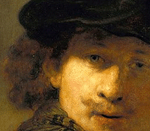
"Jesus Appears to the Holy Women"
In 1885 Tissot experienced a religious vision at the Church of St. Sulpice, leading him to revive his Catholic faith and spend the remainder of his life making paintings about biblical events. Moving away from the Impressionists' and Post-Impressionists' intent to create art that reflected a changing, modern world, Tissot returned to traditional, representational styles and narratives in his watercolors. As part of this artistic effort Tissot traveled to the Middle East in 1886, 1889, and 1896 to make studies of its landscapes and cultures, which would come to distinguish his series from contemporary Biblical art through its "considerable archaeological exactitude" in striving for accuracy rather than religious emotion.
His series of 365 gouache illustrations showing the life of Christ were shown to critical acclaim and enthusiastic audiences in Paris (1894–1895), London (1896) and New York (1898–1899), before being bought by the Brooklyn Museum in 1900